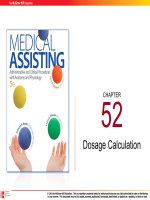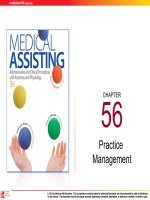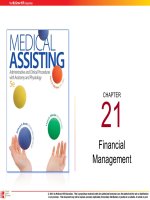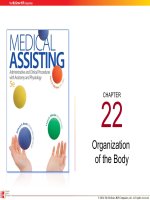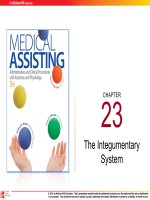Medical assisting Administrative and clinical procedures (5e) Chapter 20 Patient billing and collection
Bạn đang xem bản rút gọn của tài liệu. Xem và tải ngay bản đầy đủ của tài liệu tại đây (769.75 KB, 42 trang )
CHAPTER
20
Patient Billing and
Collection
20-2
Learning Outcomes (cont.)
20.1
Describe accounts receivable and accounts payable
and the common payment methods accepted in
medical practices today.
20.2
Identify the different types of documents used as
statements to bill patients and how these documents
are used in cycle billing.
20.3
Compare open book, written-contract, and singleentry accounts, and purpose of creating an accounts
receivable aging.
20-3
Learning Outcomes (cont.)
20.4
Explain the purposes of the following credit and
collections acts: ECOA, FCRA, and FDCPA, and
TLA.
20.5 Relate the required components of a Truth in
Lending statement.
20.6
Summarize two common types of problem collection
accounts in the medical office.
20-4
Introduction
• Payment arrangements
– Third-party payers
– Balance billing
– Payment plans
– Outstanding balances
• You must understand and administer
billing as well as payment collection
methods
20-5
Patient Payments in the Office
• Management of
– Accounts receivable (A/R)
– Accounts payable (A/P)
• Billing and collections – vital tasks
• Copayment – immediate collection
20-6
Accepting Patient Payment
• Enter charges for
services provided
• Most practices accept
–
–
–
–
Cash
Check
Credit cards
Insurance
For today’s
visit, the total
charge is $50.
How would you
like to pay?
20-7
Accepting Patient Payment (cont.)
• Cash
– Count money carefully
– Record payment
– Give patient a receipt
• Check
– Check id
– Check date and
amount
– Endorse it immediately
• Debit card
– Immediate transfer of
funds
– Processed like credit
card
20-8
Accepting Patient Payment (cont.)
• Credit card
– Check expiration date
– Keep signed receipt, give patient a copy
– Transaction fee ~ adjust patient account
– On-line payments
20-9
Payment Responsibility
• Guarantor
• Minors
– Parents or person with
legal custody
– Emancipated minor
– Divorce
• Elderly patients and patients with disabilities
– Consent
– Proof of guardianship
20-10
Payment Responsibility (cont.)
• Professional courtesy
– Waived charges or
accept amount that the
insurance pays
– Must collect
copayments
20-11
Apply Your Knowledge
What is the difference between accounts receivable
and accounts payable?
ANSWER: Accounts receivable is the money owed to the
medical practice and accounts payable is the money
owed by the medical practice.
20-12
Standard Billing Procedures
• Preparing statements
– Practice contact information
– Patient name and address
– Guarantor’s name
– Balance
– Itemized list of services and charges
– Payments received
– Total balance due
20-13
Standard Billing Procedures (cont.)
• Manual statements
• Ledger card
• Computer generated statements
• Independent billing service
• Superbill
20-14
Managing Billing Cycles
• Cycle billing
– Bills each patient monthly
– Staggers billing workload
– More even cash flow
20-15
Apply Your Knowledge
What is cycle billing?
ANSWER: Cycle billing is a system in which each
patient is billed only once a month but groups of
patients are billed every few days. It spreads the
work of billing over the month.
Excellent!
20-16
Standard Collection Procedures
• Collection of payment is
guided by
– Laws
– Professional standards
– Guidelines
• Statute of Limitations
20-17
Standard Collection Procedures (cont.)
• Statute of limitations and account types
– Open-book account ~ last payment date or
charge for each illness
– Written-contract account
• Payment agreement stipulated
• Regulated by Truth in Lending Act
– Single-entry account ~ shorter time limits
20-18
Using Collection Techniques
• Initial telephone calls or letters
– Friendly and sympathetic
– Call the patient at home
– Assume the patient forgot
– Ask for full amount
• Acceptable amount
• Expected payment date
20-19
Using Collection Techniques (cont.)
• Follow-up statements and collection letters
– 60 days past due – friendly but firm
– 90 days past due – stronger wording
– 120 days or more past due
• Final letter
• Verify cutoff date on ledger card
• Send certified/return receipt
20-20
Preparing an Age Analysis
• The process of classifying and reviewing
past-due accounts by age from the first
date of billing
– Use patient ledger cards and color-coded tags
to indicate the number of days past due
– List all patients’ account balances and when
the charges originated
20-21
Preparing an Age Analysis (cont.)
20-22
Apply Your Knowledge
True or False:
ANSWER:
Correct!
single-entry
F
An open-book account consists of only one charge.
T
A written-contract account is regulated by the Truth in
Lending Act.
T
A single-entry account might be used for a person who
will not become a regular patient.
F The statute of limitations sets an amount limit on when
an account can be filed as past due.
T
time
An age analysis is a process for reviewing past-due
accounts by age from the first date of billing.
20-23
Laws That Govern Credit and Collection
• Fair Debt Collection Practices Act of 1977
– Governs collection of unpaid debts
– Guidelines:
• Do not call before 8 A.M. or after 9 P.M.
• Do not make threats or use profane language
• Do not discuss patient’s debt with anyone else
• Do not use any form of deception or violence to
collect a debt
Laws That Govern Credit and Collection
(cont.)
• Telephone Consumer Protection Act
– Protects against telemarketing
– Prohibits
• Automated dialing to certain numbers
• Prerecorded calls to homes
• Unsolicited advertising via fax
– Most provisions do not apply to medical
practices
20-24
Laws That Govern Credit and Collection
(cont.)
• Professional guidelines
– AMA ~ appropriate to assess finance charges
or late charges on past-due accounts if the
patient is notified in advance
– The physician must adhere to federal and
state guidelines
20-25

